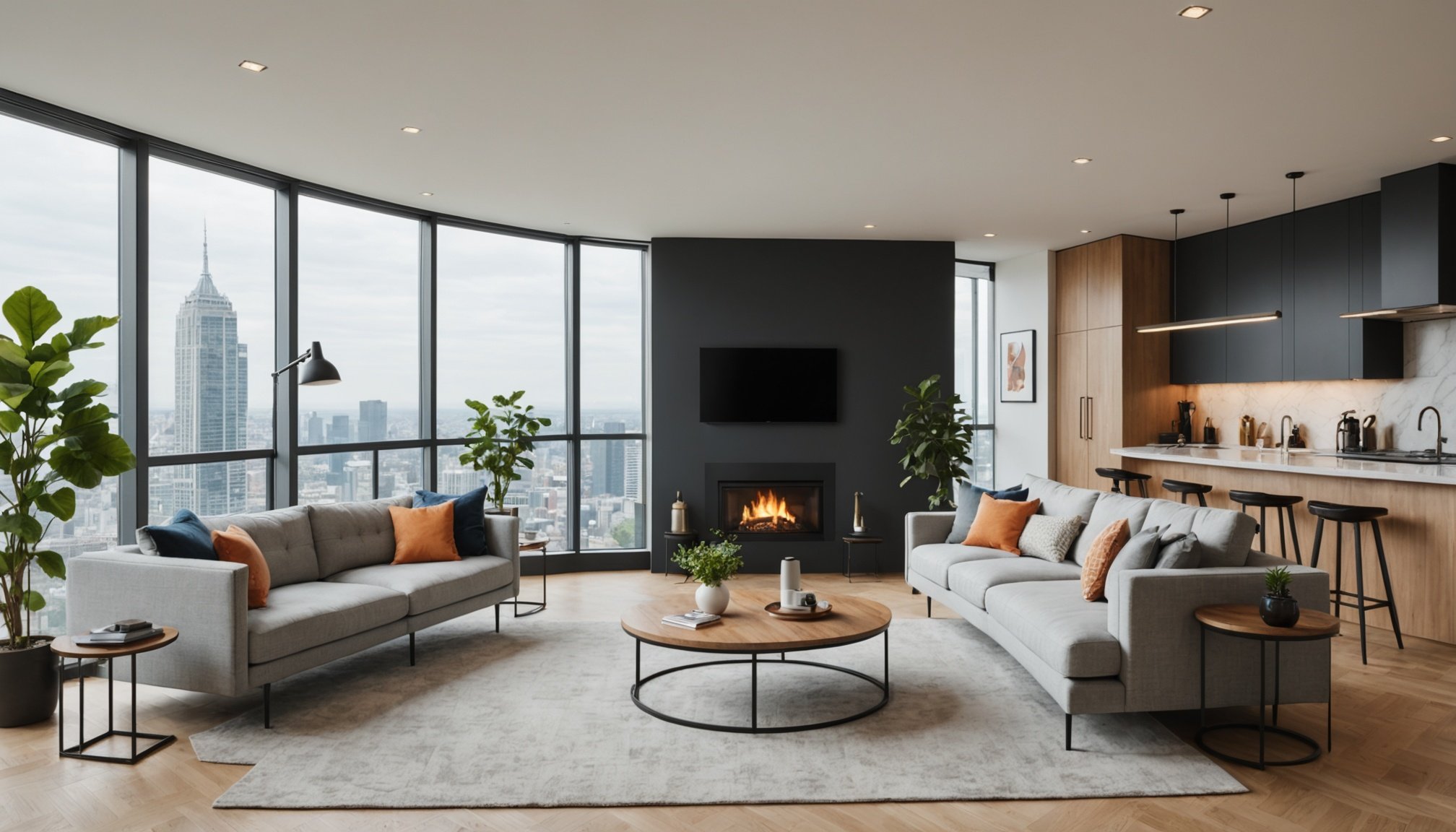Understanding Indoor Air Quality in High-Rise Apartments
Indoor air quality is a critical factor for maintaining a healthy living environment, especially in high-rise living. It refers to the quality of air within and around buildings, directly influencing apartment health. Common pollutants in these settings can include particulate matter, volatile organic compounds (VOCs), and biological contaminants such as mould and pollen. These pollutants often arise from everyday activities such as cooking, cleaning, and even from materials used in furniture and flooring.
Poor indoor air quality can have significant health implications. Exposure to these pollutants may cause or exacerbate respiratory conditions like asthma, and lead to headaches, dizziness, or fatigue. Long-term exposure can have more severe health effects.
Have you seen this : Transforming homes: key approaches to incorporating aging-in-place design in residential real estate developments
High-rise buildings often face unique challenges in ensuring adequate ventilation and air exchange due to their structural design. Such concerns emphasise the importance of recognising and addressing air quality issues to safeguard one’s well-being. Understanding these factors is the first step in creating a healthier apartment environment, ensuring that measures are put in place to mitigate these health risks. Considering effective air purification and ventilation strategies, can drastically improve the living conditions in high-rise apartments.
Effective Ventilation Strategies
Proper ventilation is essential for maintaining healthy air quality in high-rise apartments, as it ensures adequate fresh air exchange and removes pollutants. Without efficient airflow, apartments can become prone to stagnant air, which exacerbates health issues related to poor indoor air quality.
Additional reading : Designing walkable communities: a comprehensive guide to creating people-friendly mixed-use spaces
To make the most of natural ventilation, consider the apartment’s layout and take advantage of cross-ventilation by opening windows and doors when possible. Use fans strategically to direct fresh air into different areas, promoting better airflow improvement throughout the space. Opt for window treatments that allow air movement without compromising privacy, and regularly check for obstructions such as furniture blocking vents or windows.
For environments where natural airflow might be limited, implement mechanical ventilation solutions, such as exhaust fans in the kitchen or bathroom, to expel stale air and reduce humidity. Airing out the apartment using built-in HVAC systems can also ensure consistent air circulation.
Mechanical ventilation systems can considerably enhance the air exchange in spaces where securing natural airflow is challenging. These systems, equipped with energy recovery mechanisms, can effectively manage temperature and humidity, contributing significantly to an optimal living environment.
Air Purification Options
Using air purifiers effectively can transform high-rise living into healthier environments. They filter out pollutants from indoor spaces through advanced designs tailored to cater to various needs. Understanding different types of filtration systems is key to selecting the right unit for your high-rise apartment.
Types of Air Purifiers
-
HEPA Filters: Considered the gold standard, HEPA filters capture 99.97% of particles down to 0.3 microns, including dust, pollen, and smoke. Ideal for those with allergies or respiratory issues, they effectively remove contaminants in high-rise settings.
-
Activated Carbon Filters: Known for absorbing odors and VOCs, these filters are perfect for kitchens or spaces with tobacco smoke. These filtration systems neutralise gaseous pollutants, enhancing overall air quality.
-
UV Light Purifiers: By targeting biological contaminants like mold spores and bacteria, UV light purifiers offer a powerful solution for sanitising air.
Employing a combination of these technologies can provide a comprehensive clean air solution. When selecting a purifier, consider factors like room size, noise level, and filter life. Opt for smart models with air quality sensors for enhanced performance, and evaluate user reviews to determine the most reliable options.
Addressing Common Indoor Air Issues
In the unique environment of high-rise living, tackling common indoor air issues is crucial for maintaining apartment health. Addressing these can greatly enhance the quality of life in such settings.
Mold and Humidity Solutions
Mold thrives in high humidity, a frequent challenge in tall buildings. To manage this, effective solutions include using dehumidifiers and ensuring proper ventilation. Regularly inspect and clean areas prone to moisture, such as bathrooms, to prevent mold growth.
Controlling Dust and Allergens
High-rise apartments can accumulate dust and allergens quickly, exacerbating respiratory issues. Routine cleaning is essential. Use HEPA vacuum cleaners and dust-eliminating products. Additionally, maintaining proper airflow helps keep allergens in check.
Minimizing Smoke and Odors
Smoke and cooking odors can linger, especially in compact spaces. Utilise mechanical ventilation systems like kitchen extractor fans to expel these efficiently. Many opt for activated carbon filters to neutralise scents effectively in areas prone to tobacco or culinary smoke.
By understanding and addressing these issues proactively, residents can enjoy a healthier, more comfortable living environment in their high-rise homes.
Natural Remedies for Enhancing Air Quality
Incorporating natural air quality solutions into your high-rise living space can provide eco-friendly options to combat indoor pollutants effectively. While synthetic air fresheners might seem convenient, they often contain chemicals that can adversely affect apartment health. Instead, consider using natural alternatives like essential oils and beeswax candles, which release minimal volatile organic compounds.
Indoor plants are a stellar choice for improving indoor air quality. Plants like the snake plant, spider plant, and peace lily are particularly effective, as they absorb carbon dioxide and release oxygen, while simultaneously filtering out pollutants like formaldehyde and benzene. Strategically placing these plants around your apartment can lead to significant benefits in breathing fresher air.
For those interested in crafting their own solutions, several simple DIY remedies can be useful. Creating homemade air fresheners using citrus peels or baking soda can freshen up a space without adding unwanted chemicals. Additionally, maintaining proper moisture balance with natural dehumidifiers like rock salt can help reduce the risk of mold, contributing to a healthier living environment. By integrating these eco-friendly options, high-rise residents can enjoy cleaner, more breathable air in their homes.
Product Recommendations for Better Air Quality
Incorporating the right air quality products can transform your high-rise apartment environment. Choosing the essential tools ensures you address specific needs effectively, promoting apartment health.
Essential Tools for High-Rise Residents
-
Humidity Monitors and Temperature Controls: Monitoring your indoor climate helps keep levels optimal. Look for digital monitors that alert you to fluctuations, maintaining balance and supporting air quality.
-
Cleaning and Dust Reduction Products: Microfiber dusters and HEPA vacuum cleaners are ideal for trapping particulates. These tools are essential for reducing allergens and improving indoor air.
-
Smart Home Devices: Integrating devices like smart air quality monitors provides real-time data, enabling proactive management of your living space. These gadgets offer insights into pollutant levels, assisting in maintaining a cleaner atmosphere.
Final Thoughts on Product Selection
When selecting products, consider apartment size and layout, as these factors affect efficacy. Budget-friendly options are available, but for comprehensive solutions, a premium investment might offer better performance. Lastly, user reviews often serve as reliable guidance, offering personal experiences and ratings to help make informed decisions.




